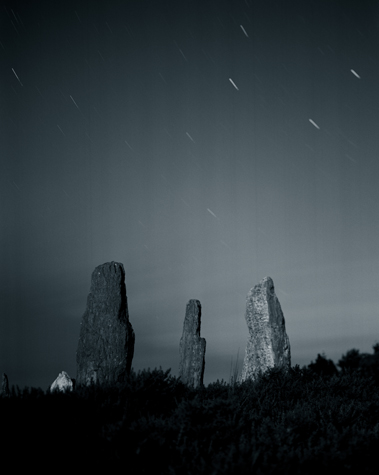Barbara Yoshida, New York, USA
Yoshida is an American artist, living and working in New York. She received her M.A. at Hunter College, and her B.A. at University of Washington. She is a former Light Work, Ucross, Blacklock Nature Sanctuary, Atlantic Center for the Arts (selected by Graciela Iturbide), and two-time MacDowell Colony fellow.
Menhirs
In 2003 I pitched my tent next to the ancient Ring of Brodgar in Scotland and photographed from evening through the night until dawn. That was the beginning of this project, a series of images from at least ten different countries, from Sweden to Spain, featuring various standing stones.
Also called menhirs, the standing stones are megalithic, with the earliest ones having been erected around 3,500 to 2,500 years B .C. Although some of them have burial sites beneath then, we really don't know anything about who constructed them or why. This mystery is one of the things that draws me to them. As Keith Carter says, "I always love what I don't understand."
Besides being intrigued by the mystery surrounding the menhirs, I am also drawn to them because they are romantic. For me, romance is about the meeting of heaven and earth. These ancient people were obviously spiritual and were aware of a power greater than themselves. They chose the stones and erected them so that they pointed to the heavens - the menhirs were definitely connectors between earth and sky. Photographing at night, with the stones against the night sky, reinforces this connection. It also emphasizes the shapes of the stones as well as the relationship between "figure and ground," between the focal object and its surroundings.
The very act of human questing is romantic to me. Many of these stones are difficult to find and must almost be stumbled upon. Romance has an element of adventure to it, and adventure is going into the unknown. And being in the presence of a great work of art involves an element of romance that transports us to another place without time. There is a timeless quality about the stones themselves. As Isamu Noguchi said, "A stone is that from which we come, is that to which we go back, it's the earth itself."
In addition, the moon to this day has a mysterious power to incite human beings to romance and other more or less transcendent otions. I love to photograph at night, using moonlight as the only light source. The quality of moonlight is different than daylight intriguing, mysterious and loaded with historical and artistic reference as well as spiritual and emotional significance.
The otherness of stones and stars like that of wild animals, is their deepest mystery, for they are not our products and their purposes are their own. They are the models for thinking our humbleness in the universe and they are the key to the strangeness of ourselves. (Paul Shepard)

Collections
Museet for Fotokunst, Denmark
Southeast Museum of Photography
Frederick R. Weisman Art Museum
The Huntington Gardens Art Collection
Polaroid Corporation
Light Work








